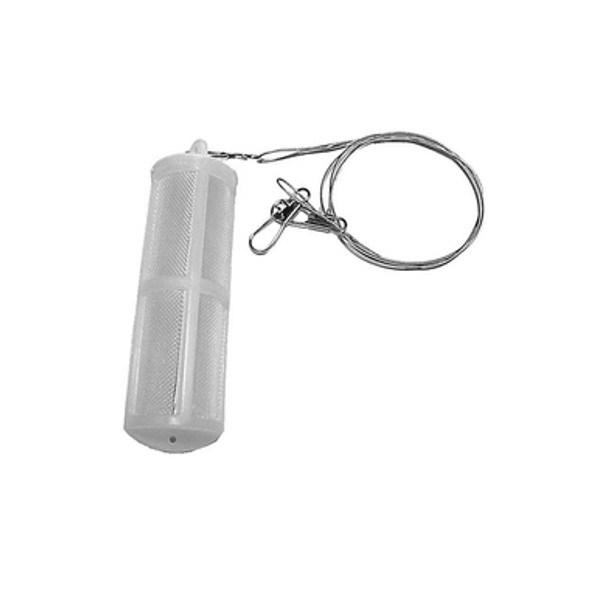Description
Tef-Gel Corrosion Eliminator & Anti-Seize Lubrication
Tef-Gel™ is derived from a specially formulated Teflon paste and is used in high corrosive environments to ensure serviceability and presentation of assembled hardware.
Tef-Gel™ is designed to perform in areas of Rust Prevention, Corrosion Elimination, and as an Anti Seize Lubricant.
Tef-Gel Tourque Pounds
| The Affect Tef-Gel™ has on Wet Assembly Fastener Torque | ||||||||||||||||
| Assembly Description through T-1 Bolting Plate | ||||||||||||||||
| ||||||||||||||||
| Tef-Gel™ was applied liberally to coat all friction points of the assembly with 10-24 stainless Steel Screws use 42in. lbs. as the assembly Torque. | ||||||||||||||||
Tef-Gel™ Food Grade Listing
Note: Additions shall not be made to this document without prior evaluation and acceptance by NSF International.
NSF International/Nonfood Compounds Registration Program
789 N. Dixboro Rd. / Ann Arbor, MI 48105-9723 USA
(734) 769-8010 / (888) NSF-FOOD / Fax: (734) 827-7179
www. nsfwhitebook. org / E-mail: nonfood@nsf. org
OFFICIAL LISTING
NSF International Certifies that the products appearing on this Listing conform to the requirements of
This is the Official Listing recorded on May 2, 2008.
ULTRA SAFETY SYSTEMS
1601 HILL AVENUE
SUITE C
PALM BEACH, FL 33407
the NSF Nonfood Compounds Registration Program
561-845-1086
Product Designation Registration Number Category Code
ULTRA Tef-Gel; Food Grade 140562 H1
Lubricants with incidental contact. H1
Tef-Gel™ Reactivity Investigation
SUBJECT: ANTISEIZE LUBRICANT REACTIVITY INVESTIGATION
Per your request we have evaluated the two anti seize products you sent me, Chesterton 785 parting lubricant and Ultra Tef-Gel (from Ultra Safety Systems, Inc), for reactivity/incompatibility.
The test method used was simple. Basically, we put a small “spatula full” of the material in a beaker and dripped on top of it a few drops of various compounds and noted the behaviour. The results are recorded on the attached data sheets. In summary, both products were for the most part unreactive. However, there are a few areas of concern. The Ultra Tef Gel gave a slight exotherm with mixed acid. No decomposition was observed, My belief is that this was caused by moisture in the product. The Chesterton 735 product was noted to have some solubility in MCB (monochlorbenzene) and certain acids, most notably nitric and mixed acids.
I hope this information is useful to you.
Jim Esancy
REACTIVITY/INCOMPATIBILITY TESTING FORM
| PRODUCT NAME: | TEF-GEL |
| SUPPLIER: | ULTRA SAFETY SYSTEMS |
| CHECK ONE: | SOLID (X) LIQUID ( ) SLURRY ( ) |
| PRODUCT COLOR: | WHITE |
| CLASSIFICATION | REACTANT | FOAMING | GASSING | HEATING | CHARRING | SOLUBILITY | STATE/COLOR CHANGE |
| ACID | SULFURIC ACID | N | N | N | N | NS | N |
| HYDROCHLORIC ACID 36% | N | N | N | N | NS | N | |
| NITRIC ACID 71% | N | N | N | N | NS | N | |
| MIXED ACID | N | N | -P | -P | NS | N | |
| ACETIC ACID GLACIAL | N | N | N | N | NS | N | |
| BASE | SODIUM HYDROXIDE 50% | N | N | N | N | NS | N |
| SODIUM CARBONATE 20% | N | N | N | N | NS | N | |
| AMMONIUM HYDROXIDE 28% | N | N | N | N | NS | N | |
| SOLVENT | ISOPROPYL ALCOHOL | N | N | N | N | NS | N |
| SOLIN 35% | N | N | N | N | NS | N | |
| DIETHLENE GLYCOL | N | N | N | N | NS | N | |
| MONOCHLOROBENZENE | N | N | N | N | NS | N | |
| ACETONE | N | N | N | N | NS | N | |
| OXIDIZER | HYDROGEN PEROXIDE 35% | N | N | N | N | NS | N |
| BLEACH 12% | N | N | N | N | NS | N | |
| REDUCER | SODIUM SULFHYDRATE 45% | N | N | N | N | NS | N |
| SODIUM BISULFITE 205 | N | N | N | N | NS | N |
DEFINITION:
| Foaming = Persistent emulsion layer which remains after gas evolution or stirring. | +P = Extremely Positive | SS = Slightly Soluble |
| Gassing = Evolution of gas evidenced by bubbles or cloud formation eminating from reaction mass. | -P = Slightly Positive | NS = Not Soluble |
| Heating = Exotherm physically sensed by touching reaction vessel. | S = Soluble | N = Non Reactive |
| Charging = Darkening or blackening of mixture due to decompression. | P = Moderately Positive | |











